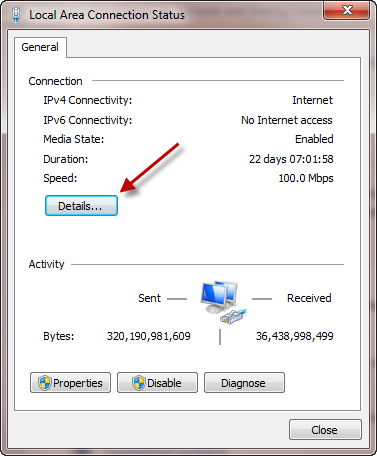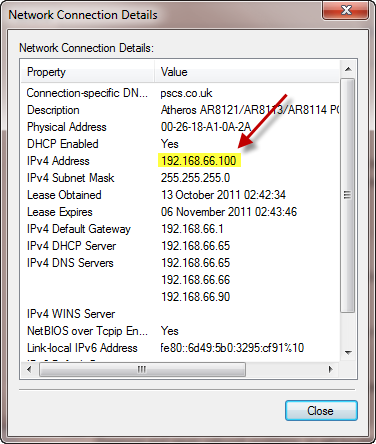When setting up email clients to connect to VPOP3, you will need to specify a server address (for POP3, SMTP and/or IMAP4). If you don't know what this should be, then these instructions may help. If you are not the technical contact at your company, then you should contact them first, because they may know a 'better' answer.
IP Address
The simplest method to determine the address of the server is to find the server's IP address. Most computers will have two IP addresses, and internal address, and an external address. Use the internal address if you will be accessing VPOP3 across the local network, and the external address if you will be accessing VPOP3 across the Internet.
You need to follow all of these procedures from the computer running the VPOP3 software.
Internal address
There are two main ways of determining this address:
GUI method
This way depends on which version of Windows you are using. These instructions are for Windows 7
- Go to Start -> Control Panel
- Go to either Network and Internet -> View Network Status And Tasks or Network and Sharing Center
- Click on Local Area Connection (the exact name may vary, but it is always in the indicated position)
- You should get a Local Area Connection Status window. Click on Details...

- In the Network Connection Details window, look at the IPv4 Address value.

That is the IP address of this computer on your network
Command line Method
This way is the same for all versions of Windows.
- Go to Start -> Run and type cmd then press Enter
- Type ipconfig and press Enter
- In the text that is displayed, you need to look for the line beginning with IPv4 Address and use that value.
You may need to scroll up in the command prompt window if the text has overflowed a single screen.
External Address
If you have a static IP address from your ISP then you can use the external IP address which they have provided you with. If you have a dynamic IP address from your ISP, then this will not work reliably, so you should use the Dynamic DNS method below, or ask your ISP for a static IP address
If you do not know the static IP address which your ISP has provided you with, then you search on Google or Bing for "what is my ip address"
DNS name
Using a DNS name is easier for users to remember, but it is considerably harder to configure
Internal
To use a DNS name internally, you need to have an internal DNS server, or an external DNS server which can provide an internal IP address
If you have a Windows Server computer, then that will usually have a DNS server Role which you can enable (it is automatically enabled if you use Active Directory)
If you don't have a Windows Server computer, then you could set up a free DNS server such as ISC Bind, or a DNS server such as SimpleDNS Plus
Configuring your DNS server is beyond the scope of this document. You should consult the documentation for the particular DNS server you wish to use.
Our chargeable technical support service can do it for you if you wish. Contact us if you wish to arrange this. The current charge is £20 + VAT per incident.
External
To use a DNS name externally, the method depends on whether you have a static IP address or a dynamic address
Static IP address
If you have a static IP address and your own registered domain name, then simply go to the management console for the registered domain name and add a new Host DNS entry ('A record') with the name being what you wish, eg 'mail' or 'vpop3', and the IP address being your external static IP address. Alternatively, contact your domain hosting company and ask them to make this change for you.
Because there are so many different domain hosting companies, then we cannot give you the specifics of how to do this.
If you have registered your domain through us, then simply contact us and tell us the change you wish to make. There is no charge for this.
Dynamic DNS
If you have a dynamic IP address, then you can set up an account with a company such as dyndns.org (or one of the many other dynamic DNS services), choose a host name and either install the relevant client software on the VPOP3 computer, or configure your router accordingly).
There are so many different dynamic DNS companies, we cannot give you specifics of how to do this, but they usually have instructions you can follow.
Our chargeable technical support service can do this for you if you wish. Contact us if you wish to arrange this. The current charge is £20 + VAT per incident.
If you have set up dynamic DNS, and you have your own domain name, you can optionally configure a 'CNAME' record in your domain name configuration to set up an alias of, for instance, 'vpop3.yourname.com' to the dynamic DNS host name.